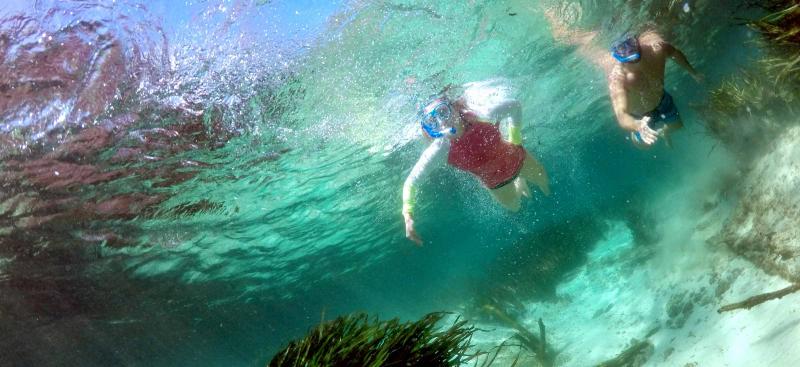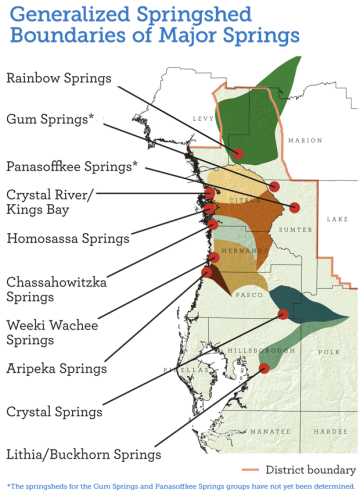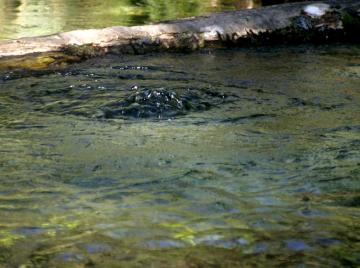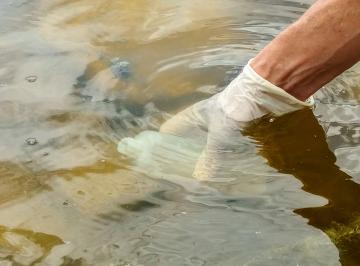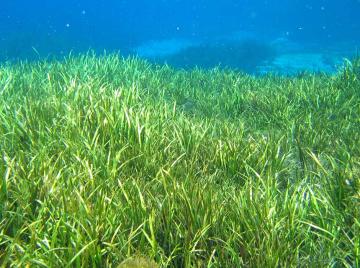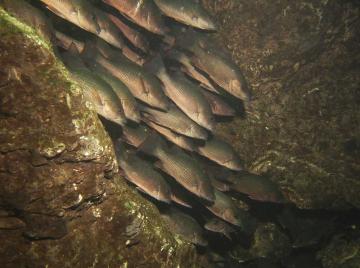What is a spring?
A spring is a natural opening in the ground where water flows directly from the aquifer to the earth’s surface. The source of this fresh water is from seasonal rainfall that soaks into the ground, which is referred to as groundwater. Springs form when groundwater is under pressure and flows up through an opening called a spring vent, supplying flow to a river or other water body. A spring can occur individually or as a group of many springs. The most common classification of Florida's springs is by their magnitude.
What is a first-magnitude spring?
The magnitude of a given spring is based on its discharge. First-magnitude springs discharge 64.6 million gallons per day or more. There are five first-magnitude spring groups in the District — Rainbow Springs, Crystal River/Kings Bay, Homosassa Springs, Chassahowitzka Springs and Weeki Wachee Springs. Together, they discharge more than one billion gallons of water per day.
What is a springshed?
A spring is only as healthy as its springshed, which is the area of land that contributes water to a spring. This area includes much more than just the land surrounding a spring. For example, the Rainbow Springs Group has a springshed that covers several hundred square miles and extends into three counties. Your actions at home, which may be many miles from a spring, can affect the health of the spring and the water flowing from it. Find out if you live in a springshed by clicking here and placing your address in the search bar in the top right corner.
Why are springs important?
Florida’s springs and their associated rivers and bays have tremendous ecological value, and are home to countless plants and animals. Spring vents are windows into the aquifer, which is the major source of our drinking water.
Additionally, the springs’ crystal, calm flows and constant temperatures make them an ideal spot for a variety of recreational opportunities. Some ways people enjoy their beauty are by snorkeling, scuba diving and kayaking. Many come seeking a glance of the springs’ most famous seasonal residents — the manatee. That interest translates to a large economic impact for the small communities that surround these systems.
What makes a healthy spring?
Springs throughout Florida and within the District vary widely in their size, ecology and human uses. However, there are four attributes that are common to healthy springs and can be used to assess their condition. They are water quantity, water quality, aquatic vegetation and fish and wildlife.
Water Quantity — Spring flow is the amount of water discharging from a spring vent, or in most cases, a collection of spring vents. The water in the Florida aquifer is the driving force for spring flow. Rainfall has a significant impact on water levels in the aquifer and on spring flow. As rain is absorbed into the aquifer, which is known as recharge, it increases the water level in the aquifer and creates greater and stronger flow in the springs. The District's Springs Coast region has one of the highest aquifer recharge rates in the state due to its karst geology. Spring flows are highest around late September and October when water levels in the aquifer peak after months of heavy summer rainfall.
Water Quality — Water quality is a broad term used to describe the overall condition of water and can include physical, chemical and biological characteristics. Many factors impact water quality, including nutrients, salinity and water clarity. Nutrients such as nitrogen and phosphorus are essential for life, but in excess can be harmful to aquatic plants and wildlife. Changing salinity is an emerging water quality issue in coastal springs, due to both variation in river flow and sea-level rise. Water clarity allows for productive aquatic vegetation and is influenced by many natural phenomena such as tannins. Because the source of water for each vent/vent cluster is different, water quality varies among springs. You can access the latest water-quality data collected by the District by visiting the Environmental Data Portal.
Aquatic Vegetation — Springs are home to a variety of plant life both along the shore and beneath its surface. The bottom-dwelling plants and algae within a spring are referred to as submerged aquatic vegetation, also known as SAV. SAV is different from seagrasses because seagrass is only found in saltwater. Underwater vegetation plays a vital role in improving water clarity by stabilizing sediments and removing nutrients. It also is food for manatees and provides habitat for fish and other organisms. SAV is an indicator of the health of aquatic ecosystems as it is sensitive to changes in water clarity, temperature, salinity and nutrient levels. These characteristics make SAV an good indicator of the aquatic ecosystem health. As a result, understanding changes in SAV communities can be used as a management tool to help protect our springs.
Fish and Wildlife – Florida springs are known for their abundance and diversity of fish and wildlife, including birds, turtles, alligators and otters. Habitats include those within the spring system itself such as submerged aquatic vegetation, and those adjacent to the spring system like wetlands and uplands. These habitats include hydric hammocks, sandhills, rocks and snags/woody debris. Coastal habitats also include oyster bars, mangroves and salt marshes. Due to their close proximity to the Gulf of America, many District springs are home to both marine and freshwater species of fish. Several springs also serve as warm water refuges for manatees in the winter, with individual manatees often returning to the same areas year after year.
How are springs threatened? »

